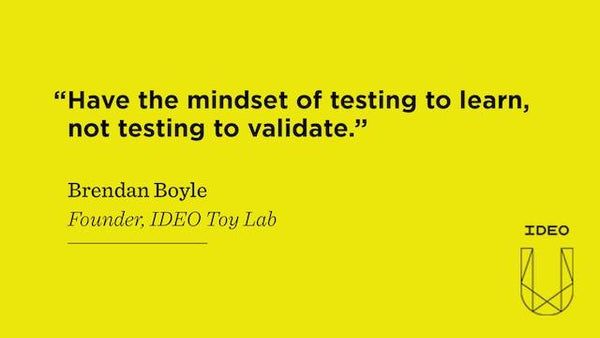Divergent Thinking and the Innovation Funnel
“Brilliant ideas often seem ridiculous.”
- Brendan Boyle, IDEO Toy Lab Founder
We sat down with IDEO Toy Lab Founder Brendan Boyle to talk about getting comfortable with divergent thinking and moving from ideation to real innovations in the marketplace. Here are a few of our favorite highlights:
Spend More Time Diverging
When ideating, go for quantity over quality. Get as many ideas out in the fewest minutes possible. We number the ideas so they’re not associated with one person and try to go for 25-50 ideas. It takes lots of ideating to get to brilliant ideas and you have to be comfortable with a bunch of your ideas not working. We also ask for the ideas as headlines; we don’t want to go deep into the idea, otherwise, it turns into a meeting. One of the most important rules is not to judge the ideas. Often, the brilliant ideas seem ridiculous. Paying to stay in another person’s home and having a stranger drive you around are great examples of seemingly ridiculous ideas—but Uber and Airbnb went on to become hugely successful companies.
Prototype Your Ideas
Take the ideas, even wild ones, and prototype them. Make something tangible and go get feedback on it. How quickly can you take those ideas and get them out into the world? Go low resolution and quick on those first prototypes. We do low fidelity prototyping but high fidelity brainstorming. Prototyping is just another way we’re continually learning. Have the mindset of testing to learn, not testing to validate. This is where many people get tripped up; they try to perfect the idea rather than use a low-fidelity prototype to learn from people. Prototypes sound intimidating, but we can help you gain prototyping confidence in From Ideas to Action.

Share Your Ideas
Share your ideas with as many people as you can. Once you start sharing ideas, you’ll get feedback on them. If you just hold onto that idea, it’s not going to be actionable. Listen to what other people have to say and have them be co-collaborators.
---
Divergent Thinking Webinar Chapters
(1:00) The innovation funnel: Create a repeatable process you can use each time you’re attempting to solve a new problem. Starting with lots of ideas is key.
(4:04) Diversity of ideas: Spend more time in divergent thinking and use a variety of ideation methods.
(7:35) Live brainstorm session: Go for quantity over quality, remember brilliant ideas often seem ridiculous, and allow time for diverging.
(10:05) Brick manufacturer brainstorm challenge: Come up with as many ideas as you can (10 or more) for creative uses for bricks.
(12:10) Fluency + flexibility: Generate a large number of ideas and a variety of diverse ideas.
(13:29) Brainstorm warm up: Warm up on an interesting and fun topic outside your industry to get people in the creative mindset.
(14:24) Converge: Move from ideation to clustering your ideas around themes and voting on the best ideas.
(16:01) Prototype your idea: Make something tangible and get feedback.
(18:41): Moon village challenge: How might we design activities that help these scientists loosen up in their first 30 days working together?
(22:42) Unique team building: Brainstorm novel ways for your team to get to know each other better.
(24:02) Course overview: Lesson 1: Ideation - techniques for ideating, diverging and how to converge. Lesson 2: Rapid prototyping - get tangible fast. Lesson 3: Iterating - test and move toward implementation.
(26:42) Fail gracefully: Talk about failures as learnings and don’t try to hide past failures.
(28:20) Criteria for converging: Consider market constraints, balance low hanging fruit with products you know your users will love.
(30:00) Prepare for brainstorming: Be intentional about who you invite to the brainstorm, create lists to get everyone in ideation mode.
(31:39) Manage ideation expectations: Set a culture of ideas belonging to everyone on the team, have fun with ideation, and give ideas as headlines so the ideation session doesn’t turn into a meeting.
(34:25) Prototyping tools: Start with low resolutions tools: paper, tinfoil, cardboard, sketches, webflow, word docs, etc…
(37:03) Prototype a service: Experiment with live prototyping instead of using a focus group.
(40:27) Share your idea: Share with as many people as you can. Start getting feedback from people you trust.
(41:48) Innovate in traditional organizations: Start with small experiments and get some momentum going.
Build new skills and learn how to move from ideas to real innovations in the marketplace. Check out our From Ideas to Action online course.
- choosing a selection results in a full page refresh
- press the space key then arrow keys to make a selection



